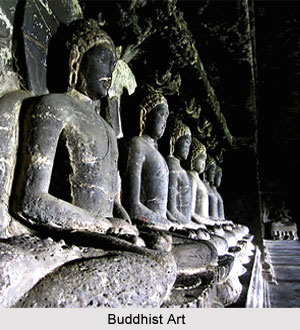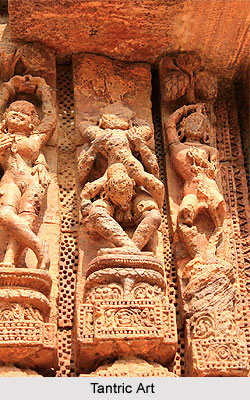 Religion has, over the years, played muse to Indian art. Religious beliefs, such as, Hinduism, Buddhism, and Jainism, have provided several themes which had enabled the variant art forms in India to flourish. In fact, it would not be completely wrong to state that in India art is religion and religion is art. At the very beginning Indian symbols of art voiced the same truth as Indian philosophy and myth. Religious texts of Hinduism and Buddhism specifically stated that making of images leads to heaven.
Religion has, over the years, played muse to Indian art. Religious beliefs, such as, Hinduism, Buddhism, and Jainism, have provided several themes which had enabled the variant art forms in India to flourish. In fact, it would not be completely wrong to state that in India art is religion and religion is art. At the very beginning Indian symbols of art voiced the same truth as Indian philosophy and myth. Religious texts of Hinduism and Buddhism specifically stated that making of images leads to heaven.
Indian art in all periods is close to the lives of all creatures on earth. Under the Buddhist influence, Indian sculptures were made with an understanding of actual human anatomy though not much accurate in scientific terms. For example, the sculptures of the yakshis at Sanchi Stupa can be described as a visualisation based on experience. The Mathura school of Art and Gandhara School of Art and Sculpture which flourished during the reign of Kanishka of the Kushana Empire has strong influence of Buddhism. But Buddhist art reached its zenith during the Gupta period. Whilst the north Indian kingdoms showered their patronage on both Buddhist and Hindu forms of art, the scenario down south was quite different. The imperial Cholas, the kingdom of Vijayanagar Empire, Cheras and other dynasties encouraged the development of Dravidian art and sculpture. Built out of stone, the temples in South India narrate tales of the brilliant craftsmanship of the by-gone eras. One of the greatest instainstances of India art still lives in the ancient village of Hampi.
 The medieval era of Indian art was hugely influenced by the spread of Islam. The Islamic period in turn was inspired by Persian art. The amalgamation of Indo-Islamic style was introduced in India by the Delhi Sultanate. The foreigners brought rich innovative ideas into Indian art. The influence of Islamic art reached its peak under the Mughals and was spotted in all major forms of paintings, pottery, ceramics and miniatures. The influence of Hindu religion is greatly perceived in the Rajput art forms. But the Rajput paintings also reflect Mughal influence. The theme of the paintings revolves around the epics of Ramayana and the Mahabharata and the life of Lord Krishna. The Rajputs paintings of Amber and Jaipur bear Mughal influence because at that time the Mughals ruled the princely state of Rajasthan. Hinduism, during this era, has cast its influence on the temple architecture of southern India. The colossal structures and the sculptures engraved in these shrines speak volumes about the deft artistry that was predominant during that era. The rampant construction of Hindu temples continued under the Hoysala Empire, Chalukya Dynasty and Rastrakuta Dynasty in South India.
The medieval era of Indian art was hugely influenced by the spread of Islam. The Islamic period in turn was inspired by Persian art. The amalgamation of Indo-Islamic style was introduced in India by the Delhi Sultanate. The foreigners brought rich innovative ideas into Indian art. The influence of Islamic art reached its peak under the Mughals and was spotted in all major forms of paintings, pottery, ceramics and miniatures. The influence of Hindu religion is greatly perceived in the Rajput art forms. But the Rajput paintings also reflect Mughal influence. The theme of the paintings revolves around the epics of Ramayana and the Mahabharata and the life of Lord Krishna. The Rajputs paintings of Amber and Jaipur bear Mughal influence because at that time the Mughals ruled the princely state of Rajasthan. Hinduism, during this era, has cast its influence on the temple architecture of southern India. The colossal structures and the sculptures engraved in these shrines speak volumes about the deft artistry that was predominant during that era. The rampant construction of Hindu temples continued under the Hoysala Empire, Chalukya Dynasty and Rastrakuta Dynasty in South India.
With the advent of Christianity, Indian works of sculpture, painting, and architecture were devoted to reveal the divine personality of the Gods and to increase the dignity of the Church. Before the intrusion of western influence, there was never in Indian art anything corresponding to the copying of nature. The sculpture and architecture of the colonial period varied from the early attempts to create the classical prototypes to the comparatively newer Indo-Saracenic style, which is a mixture of Hindu, Islamic and Western elements.
Thus, it is observed that the religious influence on Indian art is profound. The several religions which include Hinduism, Buddhism, Christianity, Islam and others at different times have immensely contributed in shaping the various styles of Indian art. The diverse spiritual inspiration and the religious beliefs added to the unique nature of Indian art.



















